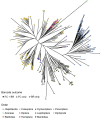Fast-tracking bespoke DNA reference database generation from museum collections for biomonitoring and conservation
- PMID: 36345645
- PMCID: PMC12142715
- DOI: 10.1111/1755-0998.13733
Fast-tracking bespoke DNA reference database generation from museum collections for biomonitoring and conservation
Abstract
Despite recent advances in high-throughput DNA sequencing technologies, a lack of locally relevant DNA reference databases limits the potential for DNA-based monitoring of biodiversity for conservation and biosecurity applications. Museums and national collections represent a compelling source of authoritatively identified genetic material for DNA database development, yet obtaining DNA barcodes from long-stored specimens may be difficult due to sample degradation. Here we demonstrate a sensitive and efficient laboratory and bioinformatic process for generating DNA barcodes from hundreds of invertebrate specimens simultaneously via the Illumina MiSeq system. Using this process, we recovered full-length (334) or partial (105) COI barcodes from 439 of 450 (98%) national collection-held invertebrate specimens. This included full-length barcodes from 146 specimens which produced low-yield DNA and no visible PCR bands, and which produced as little as a single sequence per specimen, demonstrating high sensitivity of the process. In many cases, the identity of the most abundant sequences per specimen were not the correct barcodes, necessitating the development of a taxonomy-informed process for identifying correct sequences among the sequencing output. The recovery of only partial barcodes for some taxa indicates a need to refine certain PCR primers. Nonetheless, our approach represents a highly sensitive, accurate and efficient method for targeted reference database generation, providing a foundation for DNA-based assessments and monitoring of biodiversity.
Keywords: DNA‐based monitoring; conservation; invertebrate barcoding; molecular taxonomy; museum collection; taxonomy‐informed bioinformatics pipeline.
© 2022 The Authors. Molecular Ecology Resources published by John Wiley & Sons Ltd.
Conflict of interest statement
The authors declare no conflicts of interest.
Figures
Similar articles
-
Sorting specimen-rich invertebrate samples with cost-effective NGS barcodes: Validating a reverse workflow for specimen processing.Mol Ecol Resour. 2018 May;18(3):490-501. doi: 10.1111/1755-0998.12751. Epub 2018 Feb 2. Mol Ecol Resour. 2018. PMID: 29314756
-
Next-generation DNA barcoding: using next-generation sequencing to enhance and accelerate DNA barcode capture from single specimens.Mol Ecol Resour. 2014 Sep;14(5):892-901. doi: 10.1111/1755-0998.12236. Epub 2014 Feb 19. Mol Ecol Resour. 2014. PMID: 24641208 Free PMC article.
-
Detecting invertebrate species in archived collections using next-generation sequencing.Mol Ecol Resour. 2017 Sep;17(5):915-930. doi: 10.1111/1755-0998.12644. Epub 2017 Feb 27. Mol Ecol Resour. 2017. PMID: 27987268
-
Advancing taxonomy and bioinventories with DNA barcodes.Philos Trans R Soc Lond B Biol Sci. 2016 Sep 5;371(1702):20150339. doi: 10.1098/rstb.2015.0339. Philos Trans R Soc Lond B Biol Sci. 2016. PMID: 27481791 Free PMC article. Review.
-
A new way to contemplate Darwin's tangled bank: how DNA barcodes are reconnecting biodiversity science and biomonitoring.Philos Trans R Soc Lond B Biol Sci. 2016 Sep 5;371(1702):20150330. doi: 10.1098/rstb.2015.0330. Philos Trans R Soc Lond B Biol Sci. 2016. PMID: 27481782 Free PMC article. Review.
Cited by
-
Building a DNA barcode reference collection of Hymenoptera in New Zealand.Biodivers Data J. 2024 Sep 26;12:e131701. doi: 10.3897/BDJ.12.e131701. eCollection 2024. Biodivers Data J. 2024. PMID: 39371081 Free PMC article.
References
-
- Bohmann, K. , Elbrecht, V. , Carøe, C. , Bista, I. , Leese, F. , Bunce, M. , Yu, D. W. , Seymour, M. , Dumbrell, A. J. , & Creer, S. (2022). Strategies for sample labelling and library preparation in DNA metabarcoding studies. Molecular Ecology Resources, 22(4), 1231–1246. 10.1111/1755-0998.13512 - DOI - PMC - PubMed
-
- Bohmann, K. , Evans, A. , Gilbert, M. T. P. , Carvalho, G. R. , Creer, S. , Knapp, M. , Douglas, W. Y. , & De Bruyn, M. (2014). Environmental DNA for wildlife biology and biodiversity monitoring. Trends in Ecology & Evolution, 29(6), 358–367. - PubMed
-
- Boyer, S. , Brown, S. D. J. , Collins, R. A. , Cruickshank, R. H. , Lefort, M.‐C. , Malumbres‐Olarte, J. , & Wratten, S. D. (2012). Sliding window analyses for optimal selection of mini‐barcodes, and application to 454‐pyrosequencing for specimen identification from degraded DNA. PLoS One, 7(5), e38215. 10.1371/journal.pone.0038215 - DOI - PMC - PubMed
MeSH terms
Grants and funding
LinkOut - more resources
Full Text Sources


